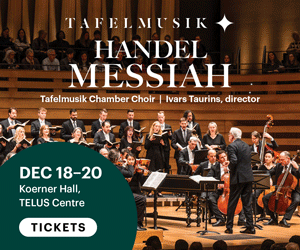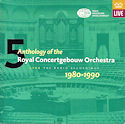 Last December’s Gramophone magazine featured an evaluation of The World’s 20 Greatest Orchestras according to the World’s Leading Critics. Third was The Vienna Philharmonic, second was The Berlin Philharmonic and at the top of the list, The Royal Concertgebouw Orchestra. Their chief conductor is Mariss Jansons who succeeded Ricardo Chailly. That orchestra has issued Volume 5, 1980-1990, of Anthology of the Royal Concertgebouw Orchestra, the penultimate set in their collection of a six decade’s worth of live performances (RCO 08005 14CDs and 84 page booklet). Conductors include Giulini, Kondrashin, Jochum, Haitink, Järvi, Sanderling, Chailly, Harnoncourt, Leinsdorf, de Waart, Colin Davis, Bernstein, Ivan Fischer, Dohnanyi, Dutoit, Albrecht, and others. One of the many highlights is Kirill Kondrashin with the most persuasive performance of Rachmaninov’s Second Symphony ever. I have umpteen versions from Vladimir Sokoloff’s 1928 Cleveland to the new Ashkenazy from the Sydney Symphony’s 2007 Rachmaninov Festival, but Kondrashin surpasses them all in overall shaping and balance, with a luxuriously self-indulgent first movement. While there are several popular works included; Tchaikovsky’s Sixth and The Poem of Ecstasy (Dorati), Mozart 24th (Brendel/Haitink), Song of the Nightingale (Chailly), Sibelius Sixth (Colin Davis), and Schubert Fifth (Bernstein), there is also repertoire that is rarely, if ever, heard live. Certain works by Schreker, Escher, Webern, Schoenberg, Varèse, Keuris, and others may be new to one’s ears but well worth getting to know. There are 41 works in all and choosing from the wealth of repertoire and matching conductors available could not have been easy. What is included is, presumably, the best of the best. Other choices may have been different but not better. I am enjoying this set immensely. No complaints about the sound.
Last December’s Gramophone magazine featured an evaluation of The World’s 20 Greatest Orchestras according to the World’s Leading Critics. Third was The Vienna Philharmonic, second was The Berlin Philharmonic and at the top of the list, The Royal Concertgebouw Orchestra. Their chief conductor is Mariss Jansons who succeeded Ricardo Chailly. That orchestra has issued Volume 5, 1980-1990, of Anthology of the Royal Concertgebouw Orchestra, the penultimate set in their collection of a six decade’s worth of live performances (RCO 08005 14CDs and 84 page booklet). Conductors include Giulini, Kondrashin, Jochum, Haitink, Järvi, Sanderling, Chailly, Harnoncourt, Leinsdorf, de Waart, Colin Davis, Bernstein, Ivan Fischer, Dohnanyi, Dutoit, Albrecht, and others. One of the many highlights is Kirill Kondrashin with the most persuasive performance of Rachmaninov’s Second Symphony ever. I have umpteen versions from Vladimir Sokoloff’s 1928 Cleveland to the new Ashkenazy from the Sydney Symphony’s 2007 Rachmaninov Festival, but Kondrashin surpasses them all in overall shaping and balance, with a luxuriously self-indulgent first movement. While there are several popular works included; Tchaikovsky’s Sixth and The Poem of Ecstasy (Dorati), Mozart 24th (Brendel/Haitink), Song of the Nightingale (Chailly), Sibelius Sixth (Colin Davis), and Schubert Fifth (Bernstein), there is also repertoire that is rarely, if ever, heard live. Certain works by Schreker, Escher, Webern, Schoenberg, Varèse, Keuris, and others may be new to one’s ears but well worth getting to know. There are 41 works in all and choosing from the wealth of repertoire and matching conductors available could not have been easy. What is included is, presumably, the best of the best. Other choices may have been different but not better. I am enjoying this set immensely. No complaints about the sound.
Royal Concertgebouw Orchestra Anthology Vol.5![]()
At Grigorian.com
Esoteric, the Japanese company that manufactures high quality CD players, amplifiers and speakers, is producing CDs derived from existing analogue masters that are, from the two that I have heard, quite astonishing! Incidentally, these two discs are superior to any of the Japanese XRCD discs from JVC that I have heard.
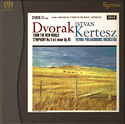 Decca’s Dvorak Ninth Symphony with Istvan Kertesz and the Vienna Philharmonic (ESSD 90015, SACD hybrid) never had quite this impact. The dynamics are true-to-life and the orchestra between the speakers has body, not just sound. This is what Decca’s team must have heard live in the Sofiensaal in 1961. Through the courtesy of American Sound in Richmond Hill, employing state-of-the-art equipment, I compared this SACD/CD to the original SXL LP pressing and found that the sound was remarkably similar, the CD sounding more articulate in the bass and more dynamic, with some finer details in the winds. The bottom line is that the Esoteric disc sounds very analogue, dynamic and a must-have for those for whom analogue is their raison d’être. Kudos to Esoteric certainly but also to Decca, whose exquisite technology produced the original master tapes that contained all this newly revealed information.
Decca’s Dvorak Ninth Symphony with Istvan Kertesz and the Vienna Philharmonic (ESSD 90015, SACD hybrid) never had quite this impact. The dynamics are true-to-life and the orchestra between the speakers has body, not just sound. This is what Decca’s team must have heard live in the Sofiensaal in 1961. Through the courtesy of American Sound in Richmond Hill, employing state-of-the-art equipment, I compared this SACD/CD to the original SXL LP pressing and found that the sound was remarkably similar, the CD sounding more articulate in the bass and more dynamic, with some finer details in the winds. The bottom line is that the Esoteric disc sounds very analogue, dynamic and a must-have for those for whom analogue is their raison d’être. Kudos to Esoteric certainly but also to Decca, whose exquisite technology produced the original master tapes that contained all this newly revealed information.
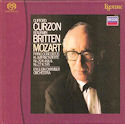 Mozart’s Piano Concertos 20 and 27 played by Clifford Curzon with Benjamin Britten conducting the English Chamber Orchestra recorded by Decca in 1970 also enjoy an Esoteric sonic renaissance. Because of the less expansive dynamic range there are no sonic fireworks but nevertheless the remastering reveals a subtly heightened sense of reality (ESSD 90014, SACD hybrid). There are two more discs in this first release from Esoteric, de Falla’s The Three Cornered Hat with Ansermet and Beethoven Overtures with Colin Davis. I look forward to hearing them. Beautifully packaged like a hard cover book, these discs sell for, gulp! $74.99 each. However, it appears that audiophiles who hear them are lapping them up.
Mozart’s Piano Concertos 20 and 27 played by Clifford Curzon with Benjamin Britten conducting the English Chamber Orchestra recorded by Decca in 1970 also enjoy an Esoteric sonic renaissance. Because of the less expansive dynamic range there are no sonic fireworks but nevertheless the remastering reveals a subtly heightened sense of reality (ESSD 90014, SACD hybrid). There are two more discs in this first release from Esoteric, de Falla’s The Three Cornered Hat with Ansermet and Beethoven Overtures with Colin Davis. I look forward to hearing them. Beautifully packaged like a hard cover book, these discs sell for, gulp! $74.99 each. However, it appears that audiophiles who hear them are lapping them up.
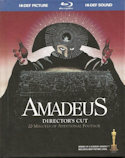 The DVD companies also have been achieving remarkable results as they, too, re-master for Blu-ray HD discs. I am deeply impressed with the director’s cut of Milos Forman’s 1984 masterpiece, Amadeus, based on Peter Shaffer’s play. There are 20 minutes of extra footage added to the original version and a substantial documentary involving all the principals, before and behind the cameras, on the making of the film. This two disc Blu-ray set from Warner Brothers is a treasure both visually and intellectually.
The DVD companies also have been achieving remarkable results as they, too, re-master for Blu-ray HD discs. I am deeply impressed with the director’s cut of Milos Forman’s 1984 masterpiece, Amadeus, based on Peter Shaffer’s play. There are 20 minutes of extra footage added to the original version and a substantial documentary involving all the principals, before and behind the cameras, on the making of the film. This two disc Blu-ray set from Warner Brothers is a treasure both visually and intellectually.
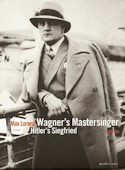 Wagner’s Mastersinger: Hitler’s Siegfried is the intriguing if not provocative title of The Life and Times of Max Lorenz (Medici Arts, EuroArts, 2056928 DVD+CD). Born in 1901, Max Lorenz’s career is traced from choir boy to super-star in Bayreuth and elsewhere during the 1930s and beyond. Intriguing films of his Siegfried give credence to his reputation as the heldentenor of the era. Film and narration together with comments by his contemporaries describe his social life with the in-crowd in Bayreuth. His wife was Jewish and he stood with her, despite the Nazis. He was shielded by Winifred Wagner who used her influence with Hitler on his behalf. But fame is fleeting. Lorenz sang his last Tristan in Dresden in 1960. Waldemar Kmentt recalls that “After his final performance at The Vienna Opera they just let him go home as if nothing had happened. No one from the management came to give him a proper send-off. I felt deeply ashamed for the Vienna Opera.” There are trailers of scenes from four Wagner music-dramas on the DVD featuring latter day heldentenors in leading roles that, perhaps unintentionally, confirm Dietrich Fischer-Dieskau’s summing-up, “Today you won’t find anyone who could hold a candle to him. No one. Hot air, that’s all.” The accompanying CD contains a document of Lorenz at his best. Extensive excerpts from Siegfried are conducted by Erich Kleiber, recorded in the Teatro Colón in Buenos Aires on October 4, 1938 with Max Lorenz, Erich Witte, Herbert Janssen and Emanuel List.
Wagner’s Mastersinger: Hitler’s Siegfried is the intriguing if not provocative title of The Life and Times of Max Lorenz (Medici Arts, EuroArts, 2056928 DVD+CD). Born in 1901, Max Lorenz’s career is traced from choir boy to super-star in Bayreuth and elsewhere during the 1930s and beyond. Intriguing films of his Siegfried give credence to his reputation as the heldentenor of the era. Film and narration together with comments by his contemporaries describe his social life with the in-crowd in Bayreuth. His wife was Jewish and he stood with her, despite the Nazis. He was shielded by Winifred Wagner who used her influence with Hitler on his behalf. But fame is fleeting. Lorenz sang his last Tristan in Dresden in 1960. Waldemar Kmentt recalls that “After his final performance at The Vienna Opera they just let him go home as if nothing had happened. No one from the management came to give him a proper send-off. I felt deeply ashamed for the Vienna Opera.” There are trailers of scenes from four Wagner music-dramas on the DVD featuring latter day heldentenors in leading roles that, perhaps unintentionally, confirm Dietrich Fischer-Dieskau’s summing-up, “Today you won’t find anyone who could hold a candle to him. No one. Hot air, that’s all.” The accompanying CD contains a document of Lorenz at his best. Extensive excerpts from Siegfried are conducted by Erich Kleiber, recorded in the Teatro Colón in Buenos Aires on October 4, 1938 with Max Lorenz, Erich Witte, Herbert Janssen and Emanuel List.



